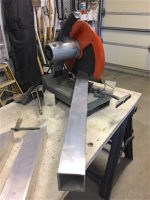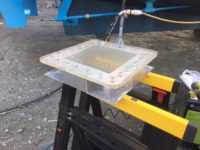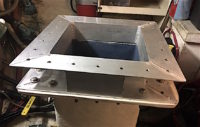The Defever 44 (and several other models) have a sea chest in the engine room. It is a square hole in the bottom of the boat with “walls” coming up above the waterline with a glass top. The sea chest, in our case about 11” square, allows for a single location for all of the rawwater (outside water) to enter the boat and be piped to the various locations for use. For example, our sea chest has an intake for both engines, both generators, both heads, the A/C, and the wash-down pump.
The bottom of the chest is open to the water, but has a grate to keep larger unwanted items from entering and clogging the intakes. The glass on the top of the chest is theoretically removable, allowing the intakes to be serviced from inside the boat.
But the “theoretical” part was a problem on our boat. Either the chest was not built tall enough initially, or the boat has settled in the water with age. (I have things that are “settling” as well). The result was when the top was removed, water came flowing in, as it was below the waterline. The fix: raise the height of the chest.
I’m far from the first to tackle this problem. Some have extended their sea chests with a fiberglass build-up, some with PVC access pipes, etc. As I calculated the problem, I figured our top was only about half an inch too low.
My approach was to extend the top with a piece of 3” square aluminum tubing, wielded together to create a 3” extension onto which the original top could be bolted. The glass top, really Plexiglas, served as a template for drilling the 24 holes to mount it to the chest and for the top itself. To help with the structural strength, I left about a third the side of each length intact. The extension was mounted on the chest using 5200 (I don’t plan on taking it off!), and the top with the original rubber seal.
Of course I installed this while on the hard, and once back in the water, the waterline seems to run someplace between about an inch below, up to about an inch up the side the new extension. But interestingly, it seems to consistently run about 2 to 3 inches below the extension when underway.
The true test will come when I have to remove the top for some reason, but I’m confident I won’t end up with an uncontrollable 11” square hole filling my engine room with seawater.




